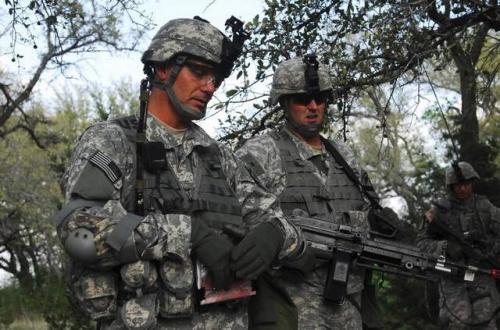 U.S. soldiers are preparing for a rotation with the NATO Response Force, marking the first time the U.S. has committed one of its primary fighting formations to the international effort. The soldiers are with the 1st Cavalry Division’s 1st Brigade Combat Team (BCT).
U.S. soldiers are preparing for a rotation with the NATO Response Force, marking the first time the U.S. has committed one of its primary fighting formations to the international effort. The soldiers are with the 1st Cavalry Division’s 1st Brigade Combat Team (BCT).
The NATO Response Force is a multinational force designed to deploy quickly wherever needed, whether it be for disaster response and humanitarian relief, or stabilization operations and combat operations. The force, which was announced in 2002, also serves as a tool to maintain and grow the ability of forces from across NATO to work together.
It is similar to the Army’s global response force, in which elements of the 82nd Airborne Division are capable of responding to contingencies around the world with little to no notice.
“It sends a strong signal when the U.S., for the first time in how long, says, ‘We’re going to be part of the NATO Response Force,’ ” said Lt. Gen. Frederick “Ben” Hodges, commander of NATO Allied Land Command, which is responsible for the effectiveness and interoperability of all NATO land forces.
“When the war started, everybody was focused on the main effort, which was Afghanistan and, of course, Iraq,” Hodges said. “The NATO Response Force continued, but the real focus was headed toward Afghanistan and Iraq. Now when we think about life after [the NATO-led International Security Assistance Force in Afghanistan], how do we maintain the interoperability we’ve achieved? There’s hope that a revitalized NATO Response Force will help to do that.”
Col. Jeffrey Kulmayer, an American officer who serves as the director of staff for the Rapid Reaction Corps-France, agreed.
“In the past, the US was just overcommitted in Iraq and Afghanistan,” he said. “We didn’t have any spare BCTs to put on standby for NATO.”
The Army’s commitment also is linked to the reduction in Europe-based forces, he said.
“When I was a lieutenant in Europe, there were 200,000 guys there,” he said. “Now we have just two brigades there, yet it’s so important to have interoperability because that’s how we’re going to fight, together.”
The U.S. also doesn’t want to lose the relationships and lessons learned from fighting alongside its NATO allies in Afghanistan for more than a decade, Kulmayer said.
“Those are perishable skills, so the NATO Response Force is a good way to maintain your combat readiness,” he said.
While the NATO Response Force is relatively new, elements of the force have been put to real-world use, Hodges said, when aviation and medical assets assisted with humanitarian aid and disaster relief after severe flooding in Pakistan in 2010. . . .
The NATO Response Force, which features troops from almost all of the NATO nations, has three pillars, Kulmayer said.
- Operational command and control is the responsibility of NATO’s two Joint Force Command (JFC) headquarters. The two four-star-led headquarters, JFC-Brunssum (Netherlands) and JFC-Naples, rotate every 12 months to be the command on standby.
- Immediate Response Force is made up of a land component command, typically a three-star corps headquarters, and a brigade-size force with combat support and combat service support. There are nine European-led corps headquarters, each with about 300 to 450 troops, that rotate on an annual basis. In 2014, the Rapid Reaction Corps-France, for which Kulmayer works, will be the corps on standby. The French also will provide the brigade-size force, if needed, in 2014.
When they’re not on standby for the NATO Response Force, these troops are conducting their nation’s business, Hodges said.
“They’re not sitting around waiting for emails from Brussels or Mons to do things,” he said. “They belong to their nations. They are all constantly looking at the world and doing their own analysis and what the potential threats are. They’re all working very hard in making sure they stay relevant and ready, not just waiting on their turn on the NATO Response Force.”
This includes deploying to Afghanistan. For example, the Rapid Reaction Corps-France did two six-month tours in Afghanistan in 2010 and 2011, Kulmayer said.
- Response Force Pool is made up of additional forces designated to augment or follow on the Immediate Response Force, if needed. The 1st BCT, 1st Cavalry Division is part of this pool. The brigade remains under US authority, but if it is called as part of the NATO Response Force, the unit is earmarked to NATO and will fall under the NATO chain of command. In 2014, the brigade, if called, will fall under the command of the Rapid Reaction Corps-France.
Image: Col. Steve Gilland, left, commander of the 1st Brigade Combat Team, 1st Cavalry Division (photo: Capt. Angel Jackson-Gillespie/Army)
